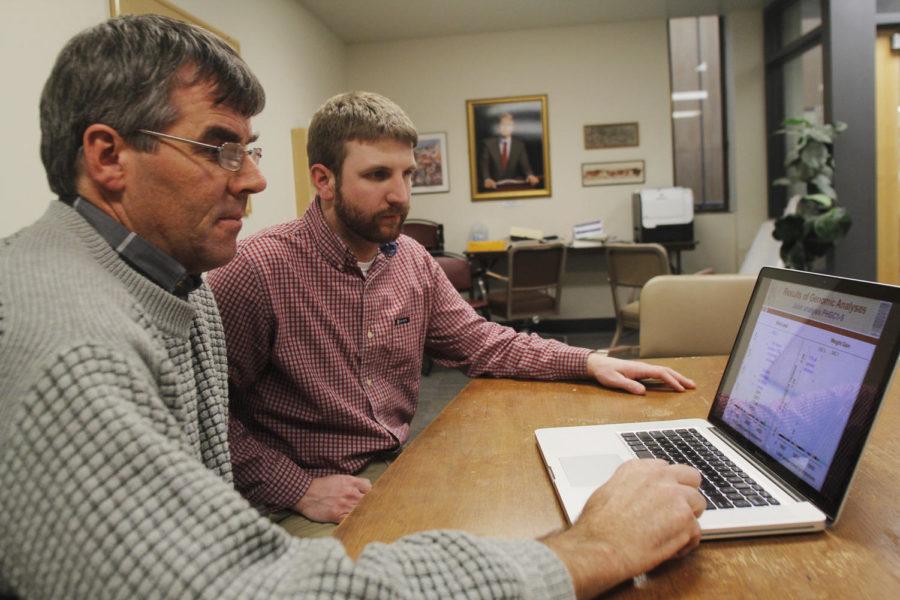ISU researchers look into disease in pigs
Photo: William Deaton/Iowa State
Jack Dekkers, professor of animal science, looks up statistical data about genomes in pigs with his research assistant, Nick Boddicker, graduate student in animal science, Jan. 22 at Kildee Hall.
January 23, 2013
Researchers at Iowa State were recently the recipients of a prestigious $3 million grant to further research of a disease that costs the U.S. pork industry nearly $664 million a year, and that’s not including the impact on animal welfare.
Jack Dekkers, professor in animal science, is leading a group of researchers in identifying and evaluating the genes in pigs susceptible to Porcine Reproductive and Respiratory Syndrome, also known as PRRS.
“PRRS is a fairly new disease,” Dekkers said. “It was discovered in 1987. Iowa State University has been at the forefront of research on PRRS right from the beginning, including research on diagnostics, vaccine development, prevention, host genetics and economic impacts on the industry.”
The disease is caused by the virus of the same name, which results in poor reproduction, including abortions and stillborn piglets, as well as in respiratory disease, poor growth and death in growing pigs. It is the most costly disease for pigs worldwide, Dekkers said.
Dekkers said one of the many problems with the disease is the fact that it spreads very easily from pig to pig and farm to farm, and there are many different forms of the virus, which is why it is very difficult to develop effective vaccines.
As the top pork-producing state in the United States, Iowa farmers have reason to be worried about the disease.
Dekkers said Porcine Reproductive and Respiratory Syndrome “is by far the most costly disease in the U.S. pork industry. Because PRRS is so infectious, it is very difficult to prevent and control.”
“With the high density of pig farms in Iowa, it is very difficult to prevent the spread of the disease from farm to farm,” Dekkers said. “Getting an outbreak of PRRS on a farm is devastating to the producer and farm workers, let alone animal welfare. Although the virus is not contagious to humans, you can imagine the impact on the morale of the producer and farm workers when a farm gets hit by an outbreak of PRRS.”
Dekkers and research team member Chris Tuggle, professor in animal science, said there are multiple factors which go into the cost of the disease. The two have been working with other researchers not only from Iowa State, but also other universities such as the University of Minnesota, Kansas State University, and the U.S. Department of Agriculture, as well as internationally with the Roslin Institute in Scotland and industry collaborators in a five-year project to find a cure for PRRS.
“If you have a PRRS outbreak, a lot of times you may lose most of the animals or a big share of the animals if it’s a real serious problem,” Tuggle said. “The standard effect will be that PRRS will go through the barn, animals will stop eating and slow down their growth and most will recover and be OK, but it takes longer for the animals to go to market and they use more feed, and it’s costly that way.”
Tuggle said producers with herds infected with the disease will often experience difficulties selling the pigs, so it can cause financial problems in that aspect as well. He said if the pigs are far enough along, they are acceptable at market. They can be sold there, especially if they are found to not be actively shedding the virus.
“A lot of times, what they’ll do is they’ll just depopulate and kill all the animals and wait until the virus is basically gone and they’ll have to repopulate the farm so it can be really devastating if you have to get rid of all your animals and you can’t get a good price for them,” Tuggle said.
However, Dekkers said, while there may not yet be a cure, there is hope for Iowa pork producers. He said the purpose of the grant will be to take the initial research findings, further develop them and bring them to application in the industry.
“Producers can reduce the risk of bringing PRRS on the farm by tight biosecurity measures,” Dekkers said. “Through this research, we plan to bring selecting pigs that have the right genetics as another tool that producers can use to combat PRRS or, at a minimum, reduce the impact of the disease when their farm does become infected with PRRS.”

















